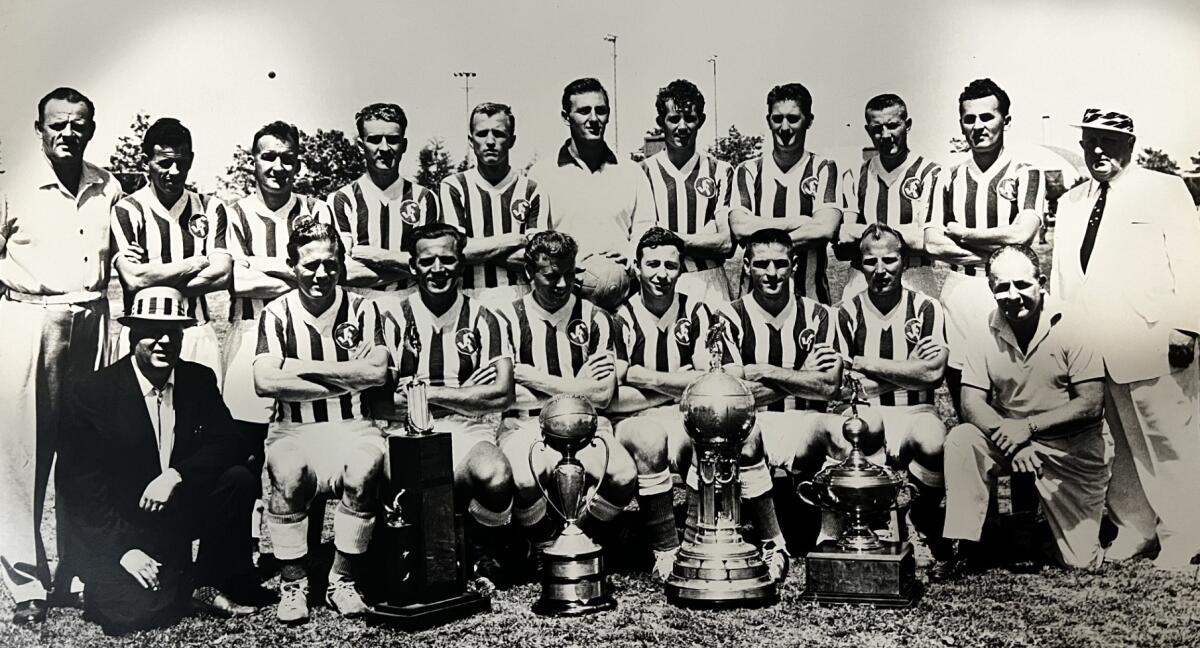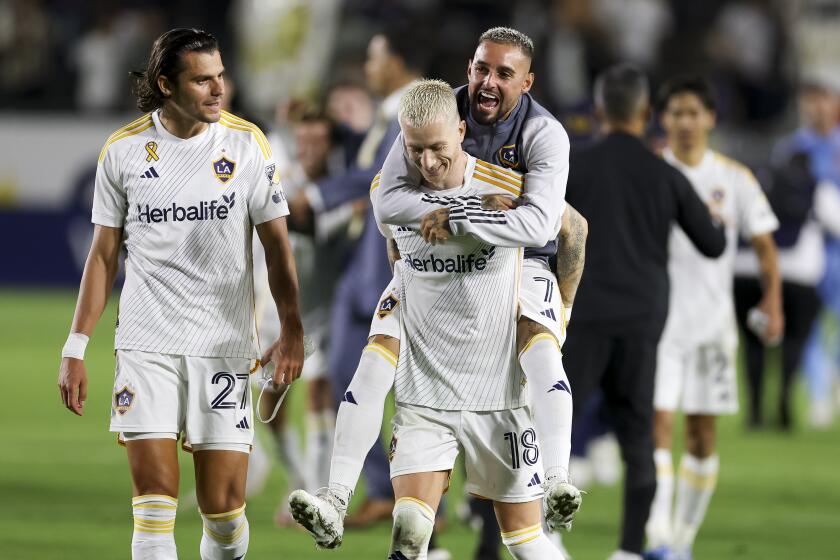L.A. Kickers players finally get their long-deserved U.S. Open Cup tribute

The last time Lothar Pospich, Manfred Norstadt and Eberhard Herz lifted the U.S. Open Cup trophy together, there were just a few thousand people in the quiet stands at Wrigley Field, a largely abandoned minor league baseball stadium in South L.A.
That was 1964, when the tournament, the oldest national soccer competition in the country, was played by largely amateur teams representing mostly ethnic clubs and neighborhoods. The players were immigrants or the sons of immigrants, playing a game that was considered a national pastime in the old country but little more than a waste of time in the new one.
“It was not like now,” said Pospich, 91. “America was in the beginning stages to play soccer.”
Sixty years later the U.S. Open Cup is back in Los Angeles, giving Pospich, Norstadt and Herz, former teammates on the L.A. Kickers, a chance to hoist the trophy once again Wednesday. They have been asked to accompany the tournament trophy onto the field at BMO Stadium — less than two miles from where Wrigley Field, which was demolished in 1969, once stood — before this year’s final between LAFC and Sporting Kansas City.
And this time the stands are expected to be loud and full with more 22,000 people.
“I have to make it one more time,” said Herz, 90. “This may be the last time, I guess.”
Archival footage from the 1960 U.S. Open Cup. (Ukrainian American Sports Center Tryzub)
The tribute is fitting because Herz, Norstadt and Pospich helped build the foundation upon which soccer, ranked by a Gallup Poll as the fourth-most-popular spot in this country, now rests.
“Soccer was not highly rated at that,” Norstadt said. “But the Kickers, they were a level higher than every other team in the United States. We had some good players on that team.”
Herz and teammates Al Zerhusen and Helmut Bicek played for the U.S. national team; Zerhusen would go to be inducted into the National Soccer Hall of Fame. But those stars mostly shone in anonymity with the Kickers, who played regular weekend double- and triple-headers before “crowds” of family and friends at Daniels Field in San Pedro and Jackie Robinson Stadium on the Westside.
“But we brought up the soccer,” Pospich said. And that changed everything.
When the three German-born players last lifted the trophy, the U.S. was an international soccer backwater, 26 years from its next World Cup appearance.
In 21 months, the country will play host to that tournament for the second time.
When Herz, Norstadt and Pospich last lifted the Cup, the launch of MLS was 28 years away. Today, MLS is the largest first-division league on the planet and its average attendance is seventh-best in the world.
The team they played for, the L.A. Kickers, is gone now, having been absorbed by the Los Angeles Soccer Club. Same with the Greater Los Angeles Soccer League, in which the Kickers played. But in the days before a competitive national team and a healthy professional league, the Kickers and the GLASL were as good as soccer got in Southern California.
The Kickers were founded in 1951 by six German ex-pats and played in a highly competitive league against other immigrant teams with names such as the Swiss Soccer club, the Los Angeles Scots, the San Pedro Italians and Austria F.C.
At the time the U.S. Open Cup was the biggest prize in the country, but until 1955, when the Los Angeles Danes lost to Herz and the New York-based S.C. Eintracht, no team west of St. Louis had ever played in the final. In an effort to change that, Albert Ebert, one of the Kickers’ founders, began recruiting players around the country to come to L.A. and play for his team.
Herz, who came to the West Coast after being drafted into the Army, and Pospich and Norstadt, who played in Toronto, were among those who answered the call. All three got their start in soccer in Germany, and when they arrived in Los Angeles they set about transforming the sport.
Eight of the 11 players the Galaxy started in Saturday’s El Tráfico win over LAFC weren’t with the team at the start of last season, and they’ve already won twice as many games.
The Kickers, with Herz, won the Open Cup in 1958 and finished second two years later, part of a streak that saw L.A. or Orange County teams make the final 21 times over the next 28 years, winning eight times.
Maccabee Los Angeles, a team of Jewish immigrants, Holocaust survivors and at least one player whose father was a Nazi party member, is one of three teams to win five titles, reaching the final seven times in its brief 11-year history.
Yet few teams have a better two-year span than the 1963-64 Kickers of Herz, Norstadt and Pospich who, in 1963, became the first American soccer club to go on a world tour, playing top teams in New Zealand, Australia, Iran and Germany. In his Glendale home, tucked among his other trophies, Norstadt, the youngest of the three at 87, has a framed copy of the full-page L.A. Times article announcing the tour.
The team then came home to win four championships in 1964, including its final U.S. Open Cup.
The last Southern California team to win that tournament was the Galaxy, which won the second of their two titles in 2005. That was also the last time the final was played here. For LAFC, which made it to the semifinals before losing on penalty kicks in its first season, 2018, a title would bring the club its first piece of hardware since the 2022 MLS Cup and end a drought that has seen it go winless in its last four finals, including last month’s Leagues Cup.
Yet they almost didn’t get the chance.
Although the Open Cup, which is contested by approximately 200 professional, semi-pro and amateur teams at all levels of the U.S. Soccer pyramid, survived two global pandemics and two World Wars in its 110-year history, it was nearly killed by MLS commissioner Don Garber last winter. The addition of the Leagues Cup, a Garber creation that MLS largely controls and profits from, had so crowded the MLS calendar that Garber pulled his teams out of the Open Cup, which is run by U.S. Soccer.
Duilio Davino, director of the Mexico men’s national team, hopes Javier Aguirre can steer the squad back to prominence as the 2026 World Cup approaches.
U.S. Soccer pushed back, blocking Garber’s request to use MLS Next Pro developmental teams in the tournament, and a compromise was struck that would see eight MLS teams, including LAFC, joining the tournament in the round of 32. That helped preserve the history and importance of one of the world’s oldest domestic cup competitions.
Sixty years after winning his last title, Norstadt, a former engineer, walks with a cane. Eberhard, who owned a liquor store, bar and restaurant, broke his leg twice playing soccer before retiring in Woodland Hills not far from Pospich, who owned an automobile dealership and played in old-timers games into his 60s and now lives in Calabasas.
On Wednesday they’re reunite for a final bow at BMO Stadium, where they’ll finally get the applause and acknowledgment they’ve long deserved.
“I won’t be able to sleep tonight,” Eberhard said. “Soccer’s always been good to me. I’m like a little kid already.”
And it’s partly because of him that other little kids can still dream of playing in a U.S. Open Cup final of their own.
⚽ You have read the latest installment of On Soccer with Kevin Baxter. The weekly column takes you behind the scenes and shines a spotlight on unique stories. Listen to Baxter on this week’s episode of the “Corner of the Galaxy” podcast.









